

How to Prepare Your Organization for Marketing Automation. For anyone working in B2B marketing, it's hard to ignore the rapid ascendance of marketing automation over the past few years.

If you take the time to dig below the undulating praise, however, you'll see that the joys of marketing automation are not as clear-cut as you might first believe. Only 2.8% of B2B enterprise marketers say marketing automation-powered campaigns achieve their demand generation goals, according to the Annuitas 2015 B2B Enterprise survey of 100+ B2B enterprise marketers from organizations with annual revenues exceeding $250 million. B2B technology analyst David Raab says almost 70% of marketers are either unhappy or only marginally happy with their marketing automation software And Bluewolf's most recent State of Salesforce study found that only 7% are seeing good, measurable ROI from their marketing automation investments. Acknowledging the Limitations of Marketing Automation Also, marketing automation means having to bring on more—not less—staff. 1.
Four Multi-Channel and Touchpoint Marketing Models. Most marketers are starting to integrate their marketing channels and marketing automation is clearly taking the lead regarding the technology.
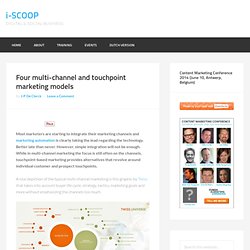
Better late than never. However, simple integration will not be enough. While in multi-channel marketing the focus is still often on the channels, touchpoint-based marketing provides alternatives that revolve around individual customer and prospect touchpoints. A nice depiction of the typical multi-channel marketing is this graphic by Twiss that takes into account buyer life cycle, strategy, tactics, marketing goals and more without emphasizing the channels too much.
TWISS Universe Multichannel Model When it boils down to touchpoint marketing, we see three kinds of models, depending on the approach. Approach 1: the buying stage. Identify Your Primary Customer - HBR IdeaCast. Robert Simons, Harvard Business School professor, says companies still struggle to choose the right customer.

For more, read his article. Download this podcast SARAH GREEN: Welcome to the HBR IdeaCast. I’m Sarah Green. I’m talking today with Robert Simons, Harvard Business School professor and author of the recent HBR article “Choosing the Right Customer, The First Step in a Winning Strategy”. Bob, thanks so much for talking with us today. ROBERT SIMONS: Well, it’s my pleasure. SARAH GREEN: So I have to ask you, you start the article by discussing several different definitions of what a customer could be, which a little bit surprised me. We've Got it Wrong: The Funnel, Lead Scoring, Conversions and More. Imagine learning how to run, but in ski boots.

You can work hard and get better at it, but it may get so exhausting that you skip the marathon and go watch TV. That’s what happens frequently in modern day organizations — we decide on building a strategy around real time marketing, but most of the time it just takes too much effort to manage proper adoption and the results don’t seem as revolutionary as we anticipated. CMO: Did You Get It Right When Creating Personas & Buyer Process Maps? Most CMO’s have created Buyer Personas.
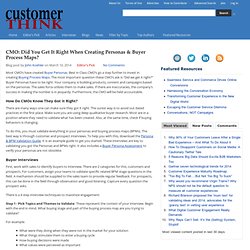
Best in Class CMO’s go a step further to invest in creating Buying Process Maps. The most important question these CMO’s ask is “Did we get it right?” Buyer Personas have to be right. Your company is building products, content and campaigns based on the personas. The sales force utilizes them to make sales. The Importance of Mapping your Buying Process. Know the 6 Stages of Your Customers' Purchase Process. Email Best-Practices for Developing and Maintaining Crucial Customer Relationships. Once marketers have learned the various basics of an email marketing campaign, they might feel they are ready to develop long-term customer plans.
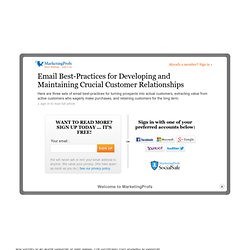
Often, however, an important missing ingredient is an understanding of the consumer "lifecycle" and how email marketing tactics should be adjusted at each lifecycle stage. At its most basic, the lifecycle consists of various stages that customers go through in regard to how they think about, purchase, or otherwise interact with a company's products. Savvy companies put in place a marketing plan for each stage in order to harness the most value from customers, and then retain those customers for as long as possible before their interest in the company's products or services ends. Here are the six lifecycle stages for customers: Prospects are "pre-customers" who need to be encouraged to learn more about the brand and convert to an active customer or user status.
In Content Marketing, 'People Buy on Emotion and Rationalize With Logic' Is a Mistake (Pt. 1) The saying "people buy on emotion and rationalize with logic" has been around so long that people rarely question it.

But in content marketing, you need to question it. Otherwise, you run the risk of either not providing people the right information or—worse—alienating your audience. The idea that people buy solely on emotion is old-school selling. Nowadays, buyers are running the show more than ever. Selling solely on emotion can make you come across as condescending and slimy. When Did You Last Map the Buying Process of Your Customers? Are the buying process maps of how your customers buy out of date?
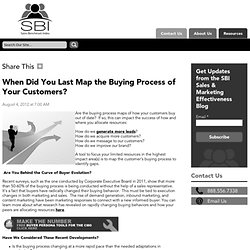
If so, this can impact the success of how and where you allocate resources: How do we generate more leads? 8 Habits Of Today’s Consumer, The COMsumer. Todays consumer habits suggest they no longer just consumes.
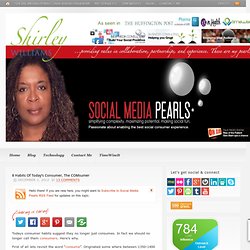
In fact we should no longer call them consumers. Here’s why. First of all lets revisit the word “consume”. Originated some where between 1350-1400 and has the following meanings: to destroy or expend by use; use up.to eat or drink up; devour.to destroy, as by decomposition or burningto spend (money, time, etc.) wastefully.to absorb; engross: consumed with curiosity.to undergo destruction; waste away.to use or use up consumer goods You see my point. I would like to propose an alternate name. The name replaces “Con” with “Com” highlighting the importance and characteristics of the 8 com-habits that I would like to propose. The-Content-Grid-v2.jpg (JPEG Image, 1361×2183 pixels) - Scaled (28%) B2B Buying Process: 8 Stages of the Business Sales Funnel. Listening is key for B2B sales success.
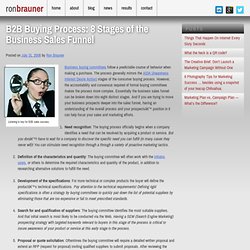
Business buying committees follow a predictable course of behavior when making a purchase. The process generally mirrors the AIDA (Awareness Interest Desire Action) stages of the consumer buying process. However, the accountability and consensus required of formal buying committees makes the process more complex. Is your CRM System a Sales Prevention System? Most sales organisations have some sort of CRM system in place. Many have made significant investments in the system. Yet simply implementing CRM – just like just running a sales training course – offers no “magic wand” for improving sales performance. In fact the energies expended on them are often wasted. Time after time, we come across Customer Relationship Management solutions that bear little or no relation to how a vendors’ most promising prospects actually buy, or what the vendors’ top performing sales people actually do.
There are 5 danger signs that indicate that a CRM system is actually behaving as a sales prevention system: 1. Consumer Buying Behavior: Understanding Five Stages Of The Buying Process. F you can't identify what stage of the buying process potential customers are in, you might as well be flying blindfolded. Consumer buying behavior is a complex mix of emotional reasons for buying and psychological and social imprints. But there is a set pattern to the buying process – whether the purchase is something simple like an apple, or complex like a car. Chapter 6. Consumer Buying Behavior Notes. Motives-- A motive is an internal energizing force that orients a person's activities toward satisfying a need or achieving a goal.
Actions are effected by a set of motives, not just one. If marketers can identify motives then they can better develop a marketing mix. MASLOW hierarchy of needs!! Physiological Safety Love and Belonging Esteem Self Actualization Need to determine what level of the hierarchy the consumers are at to determine what motivates their purchases.Handout...Nutrament Debunked...
Nutrament, a product marketed by Bristol-Myers Squibb originally was targeted at consumers that needed to receive additional energy from their drinks after exercise etc., a fitness drink. What Do Customers Want? Professor Kano Knows. How-to-Map-Your-Content-for-B2B-Marketing-Image-1.jpg (JPEG Image, 749×277 pixels) Scoring the Stages of a Buying Process. When we talk about lead scoring, the goal that comes to mind most often is determining which leads are ready for handoff to sales. Buying Process Stage Template. ContentGuideWhitepaper.pdf (application/pdf Object) Marketing and the 7 Stages of the Buying Process - Clarity Marketing - Nottingham. Building a message map. The Four Stages of The Customer's Buying Cycle - Whiteboard Wednesday Episode #5. Step-by-Step Templates for Mapping Your B2B Content. Create Content Buckets for Each Stage in the Sales Process. Every week there are sales meetings where the sales manager asks, “Where are the new opportunities/meetings going to come from?”
Target your advertising to the customer's stages in buying process. When 6 stages of the consumer buying process meet internet word of ... Prospects to Customers: 6 Stages of the Buying Process. The Customer Buying Cycle. Startup marketers need to develop a deep understanding how prospects move through the buying cycle when structuring a marketing plan that drives customer acquisition. Own a Stage in the Buyer's Process. Managerial moxie.